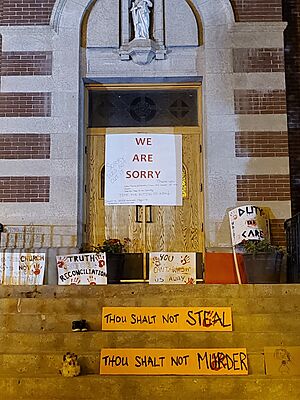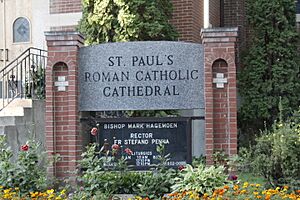St. Paul's Cathedral (Saskatoon) facts for kids
Quick facts for kids St. Paul's Co-Cathedral |
|
|---|---|
 |
|
| Religion | |
| Affiliation | Roman Catholic |
| Province | Saskatchewan |
| Ecclesiastical or organizational status | Co-Cathedral |
| Leadership | Bishop Mark Hagemoen D.D, Rector: Very Rev. Fr. Stefano Penna |
| Year consecrated | 1911 |
| Location | |
| Location | |
| Architecture | |
| Architectural type | Church |
| Architectural style | Romanesque |
| Groundbreaking | 1910 |
| Completed | 1911 |
| Website | |
| http://www.saskatoonrcdiocese.com/ | |
St. Paul's Co-Cathedral is an important parish of the Roman Catholic Church in Saskatoon, Saskatchewan, Canada. It is a main church and co-cathedral for the Diocese of Saskatoon. Because it is not very big, it cannot fully work as a main cathedral. In 2021, the building was marked with paint during protests. These protests happened after unmarked graves were found near a former residential school.
Contents
History of St. Paul's Co-Cathedral
Early Days and Construction
St. Paul's Co-Cathedral is located in the downtown area of Saskatoon. It sits at the corner of 22nd Street East and Spadina Crescent. This spot is right on the west bank of the South Saskatchewan River.
The first stone for St. Paul's was placed on July 25, 1910. This important event was done by Sir Wilfrid Laurier, who was the Prime Minister of Canada at the time. Just one year later, in 1911, the church was officially opened. Archbishop Adelard Langevin from St. Boniface, Manitoba, led the ceremony.
Becoming a Cathedral
St. Paul's was first built to be a regular parish church. A parish church serves a local community. In 1921, it became a "pro-cathedral." This means it was a temporary main church for the diocese.
Then, in 1934, the Diocese of Saskatoon was officially created. At that time, St. Paul's was made a full cathedral. A cathedral is the main church of a bishop's area. A large pipe organ, made by Casavant Frères, was put into the church in 1912.
Stained Glass Windows
The church has beautiful stained glass windows. These windows were added in 1945. They were put in to remember people who died during World War II. More stained glass was added in 1976. This was to honor those who died in a fire. The Institute for Stained Glass in Canada has recorded information about these windows.
Changing Role of the Cathedral
By the mid-1990s, the building was too small. It did not have enough space to expand. This made it hard for it to work well as a main cathedral. So, on December 18, 2011, a new church opened. This new church was called Holy Family Cathedral.
After the new cathedral opened, St. Paul's became a "co-cathedral." This means it shares the role of a main church with another cathedral. It also continues to serve as a local parish church for the community.
Art in the Co-Cathedral
In 2019, St. Paul's Co-Cathedral received two special paintings. These paintings show Saints Peter and Paul. They were created by a German artist named Berthold Imhoff. The paintings came from St. Andrew's church in Blaine Lake, which was closing down. They were shown on June 29, which is the feast day for Saints Peter and Paul. These artworks are still on display in the church's main area.
Protests and Vandalism
Discovery of Unmarked Graves
On June 24, 2021, important news was shared by Cowessess Chief Cadmus Delorme. He announced that 751 unmarked graves had been found. These graves were located near the former Marieval Indian Residential School. Many of the graves belonged to Indigenous children. These children had been forced to attend the Residential School.
Vandalism at the Co-Cathedral
On the same day, June 24, 2021, St. Paul's Co-Cathedral was marked with paint. The words "We were children" were written on the building. There were also red handprints. These markings were later cleaned off. Police said that two people put the paint on the building during a protest.
On July 2, 2021, the Co-Cathedral was marked again. More red handprints appeared on the building. This happened after more than 1,000 unmarked graves were found at other residential schools. These actions were part of protests to raise awareness about the discoveries.
External links
See also
 In Spanish: Concatedral de San Pablo (Saskatoon) para niños
In Spanish: Concatedral de San Pablo (Saskatoon) para niños




